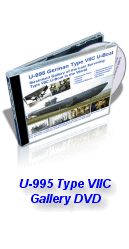

|
Radar
Radar was one of the key developments which played a decisive role in turning the odds in favor of the allies. Although both the Germans and Western Allies carried out extensive research on radar development, it was the British who had the upperhand in this arena. During the war, the Germans had one of their first impressions of the effectiveness of allied radar when the Bismarck was repeatedly picked up and tracked on radar by her pursuers.
The development of airborne radar also meant that allied aircraft could operate unaffected by visibility conditions, which when coupled with massive searchlights (called “Leigh Lights”), allowed planes to find and attack surfaced U-boats at night. This new threat forced U-boats to travel submerged, where it was very slow and virtually blind. New shipborne radar was also installed on escort vessels, removing the invisibility of U-boats during night surfaced attacks. By 1942, U-boat commanders quickly became aware that aircraft were appearing too often for it to be due to visual sightings and correctly concluded that radar was to blame.
 |
 |
 |
German radar was primitive in comparison to the allied counterpart. Although radar had been installed on German surface warships from 1937, they were low powered and had low frequencies which limited their range and sensitivity. The first proposal for a U-boat radar was placed as early as 1939, but this project was ignored as the infatuation was at that time with big unsinkable battleships. In fact it was not until 1942 which saw a remarked increase in air attacks on U-boats, that the project was revived again. By then, the Germans were lacking behind but the capture of allied radar sets helped close the widening gap.
FuMO-29 GEMA
Not surprisingly, the first U-boat radar was a conversion of a shipborne set intended for surface ships. Known as Funkmessortungsgerat (radar detention apparatus) and abbreviated to FuMO, this set was also referred to as GEMA, after the manufacturer that produced it. It was installed beginning in 1942 in a few Type VIIs and IXs. This set had a very narrow detection coverage of 10 degrees on each side of the bow, which meant that the U-boat had to make an almost complete circle to cover a 360 degree sweep. The range was 7,500 meters against surface vessels and 15,000 meters against aircraft.
FuMO-30 GEMA
Essentially the same set as the FuMO-29, the only difference being the antenna. This set utilized a rotatable antenna which had to be manually turned by a handwheel in the radio room. The antenna was not watertight, which meant it had to be stowed away before diving.
FuMO-61 Hohentwiel
Beginning March 1944, this set began to be installed on Type VIIs and IXs. This was adapted from the Luftwaffe FuMG-200 Hohentwiel radar which was fitted on the Focke-Wulf FW200 Condor. It had a range of 7,000 meters against surface vessels and 20,000 meters against aircraft.
FuMO-391 Lessing
The Lessing was designed specifically to detect aircraft presence and was intended to be installed on the Type XXI. It could detect aircraft up to a 30,000 meters radius, but could not indicate its height or location. A unique feature is that this set could also function while snorkeling, although the range was somewhat reduced.



